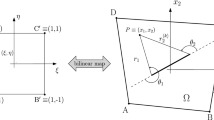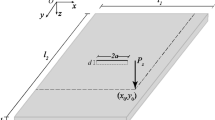Abstract
This paper deals with analyzing the nonlinear vibration of an isotropic cracked plate interacting with an air cavity. A part-through surface crack with variable orientations and positions is considered and modeled using the modified line spring model. In the first step, based on the Von Karman theory, the governing equation of the nonlinear vibration related to the cracked plate–cavity is presented. Then, by employing the Euler equation along with the Galerkin method, the coupling effect between the fluid–solid media inside the enclosure is eliminated. In the next step, the variational iteration method (VIM) is introduced as an appropriate method for nonlinear analysis of the mentioned system. To this end, the convergence of the nonlinear coupled natural frequencies with high precision is proved by performing four iterations of VIM. Finally, the effect of the length, angle, and position corresponding to the crack as well as the cavity depth on the frequency ratio is inspected for various boundary conditions by plotting three and four-dimensional backbone curves. It is revealed that the crack angle is the most effective parameter on the frequency ratio.










Similar content being viewed by others
References
Rice JR, Levy N (1972) The part-through surface crack in an elastic plate. J Appl Mech 39(1):185–194
Israr A, Cartmell MP, Krawczuk M, Ostachowicz WM, Manoach E, Trendafilova I, Shishkina E, Palacz M (2006) On approximate analytical solutions for vibrations in cracked plates. In: Keogh PS (ed) Applied mechanics and materials. Trans Tech Publ, Zurich, pp 315–322
Israr A (2008) Vibration analysis of cracked aluminium plates. University of Glasgow, Glasgow
Israr A, Cartmell MP, Manoach E, Trendafilova I, Krawczuk M, Arkadiusz Ĺ (2009) Analytical modeling and vibration analysis of partially cracked rectangular plates with different boundary conditions and loading. J Appl Mech 76(1):011005
Yang J, Hao Y, Zhang W, Kitipornchai S (2010) Nonlinear dynamic response of a functionally graded plate with a through-width surface crack. Nonlinear Dyn 59(1–2):207–219
Ismail R, Cartmell M (2012) An investigation into the vibration analysis of a plate with a surface crack of variable angular orientation. J Sound Vib 331(12):2929–2948
Bose T, Mohanty A (2013) Vibration analysis of a rectangular thin isotropic plate with a part-through surface crack of arbitrary orientation and position. J Sound Vib 332(26):7123–7141
Joshi P, Jain N, Ramtekkar G (2014) Analytical modeling and vibration analysis of internally cracked rectangular plates. J Sound Vib 333(22):5851–5864
Diba F, Esmailzadeh E, Younesian D (2014) Nonlinear vibration analysis of isotropic plate with inclined part-through surface crack. Nonlinear Dyn 78(4):2377–2397
Joshi P, Jain N, Ramtekkar G (2015) Analytical modelling for vibration analysis of partially cracked orthotropic rectangular plates. Eur J Mech-A/Solids 50:100–111
Joshi P, Gupta A, Jain N, Salhotra R, Rawani A, Ramtekkar G (2017) Effect of thermal environment on free vibration and buckling of partially cracked isotropic and FGM micro plates based on a non classical Kirchhoff’s plate theory: an analytical approach. Int J Mech Sci 131:155–170
Azizi S, Fattahi A, Kahnamouei J (2015) Evaluating mechanical properties of nanoplatelet reinforced composites under mechanical and thermal loads. J Comput Theor Nanosci 12(11):4179–4185
Safaei B, Moradi-Dastjerdi R, Behdinan K, Qin Z, Chu F (2019) Thermoelastic behavior of sandwich plates with porous polymeric core and CNT clusters/polymer nanocomposite layers. Compos Struct 226:111209
Safaei B, Moradi-Dastjerdi R, Qin Z, Chu F (2019) Frequency-dependent forced vibration analysis of nanocomposite sandwich plate under thermo-mechanical loads. Compos B Eng 161:44–54
Safaei B, Fattahi A (2017) Free vibrational response of single-layered graphene sheets embedded in an elastic matrix using different nonlocal plate models. Mechanics 23(5):678–687
Qin Z, Pang X, Safaei B, Chu F (2019) Free vibration analysis of rotating functionally graded CNT reinforced composite cylindrical shells with arbitrary boundary conditions. Compos Struct 220:847–860
Pretlove A (1965) Free vibrations of a rectangular panel backed by a closed rectangular cavity by a closed rectangular cavity. J Sound Vib 2(3):197–209
Qaisi MI (1988) Free vibrations of a rectangular plate-cavity system. Appl Acoust 24(1):49–61
Nakanishi S, Sakagami K, Daido M, Morimoto M (1999) Effect of an air-back cavity on the sound field reflected by a vibrating plate. Appl Acoust 56(4):241–256
Lee Y (2002) Structural-acoustic coupling effect on the nonlinear natural frequency of a rectangular box with one flexible plate. Appl Acoust 63(11):1157–1175
Lee Y, Guo X, Hui CK, Lau CM (2008) Nonlinear multi-modal structural/acoustic interaction between a composite plate vibration and the induced pressure. Int J Nonlinear Sci Numer Simul 9(3):221–228
Fattahi A, Mondali M (2013) Analytical study on elastic transition in short-fiber composites for plane strain case. J Mech Sci Technol 27(11):3419–3425
Fattahi A, Mondali M (2014) Theoretical study of stress transfer in platelet reinforced composites. J Theor Appl Mech 52(1):3–14
Safaei B, Fattahi A, Chu F (2018) Finite element study on elastic transition in platelet reinforced composites. Microsyst Technol 24(6):2663–2671
Li Y, Cheng L (2004) Modifications of acoustic modes and coupling due to a leaning wall in a rectangular cavity. J Acoust Soc Am 116(6):3312–3318
Li Y, Cheng L (2007) Vibro-acoustic analysis of a rectangular-like cavity with a tilted wall. Appl Acoust 68(7):739–751
Gorman DG, Trendafilova I, Mulholland AJ, Horáček J (2008) Vibration analysis of a circular plate in interaction with an acoustic cavity leading to extraction of structural modal parameters. Thin-Walled Struct 46(7–9):878–886
Xin F, Lu T, Chen C (2008) Vibroacoustic behavior of clamp mounted double-panel partition with enclosure air cavity. J Acoust Soc Am 124(6):3604–3612
Xin F, Lu T (2009) Analytical and experimental investigation on transmission loss of clamped double panels: implication of boundary effects. J Acoust Soc Am 125(3):1506–1517
Xin F, Lu T (2011) Analytical modeling of sound transmission through clamped triple-panel partition separated by enclosed air cavities. Eur J Mech A/Solids 30(6):770–782
Shen C, Xin F, Lu T (2012) Theoretical model for sound transmission through finite sandwich structures with corrugated core. Int J Non-Linear Mech 47(10):1066–1072
Hui C, Lee Y, Reddy J (2011) Approximate elliptical integral solution for the large amplitude free vibration of a rectangular single mode plate backed by a multi-acoustic mode cavity. Thin-Walled Struct 49(9):1191–1194
Tanaka N, Takara Y, Iwamoto H (2012) Eigenpairs of a coupled rectangular cavity and its fundamental properties. J Acoust Soc Am 131(3):1910–1921
Shen M, Nagamura K, Nakagawa N, Okamura M (2013) Noise reduction through elastically restrained sandwich polycarbonate window pane into rectangular cavity. J Vib Control 19(3):415–428
Sadri M, Younesian D (2013) Nonlinear harmonic vibration analysis of a plate-cavity system. Nonlinear Dyn 74(4):1267–1279
Sadri M, Younesian D (2014) Nonlinear free vibration analysis of a plate-cavity system. Thin-Walled Struct 74:191–200
Sadri M, Younesian D (2015) Vibro-acoustic analysis of a coach platform under random excitation. Thin-Walled Struct 95:287–296
Pirnat M, Čepon G, Boltežar M (2014) Structural–acoustic model of a rectangular plate–cavity system with an attached distributed mass and internal sound source: theory and experiment. J Sound Vib 333(7):2003–2018
Bose T, Mohanty AR (2015) Sound radiation response of a rectangular plate having a side crack of arbitrary length, orientation, and position. J Vib Acoust 137(2):021019
Sadri M, Younesian D (2016) Vibroacoustic analysis of a sandwich panel coupled with an enclosure cavity. Compos Struct 146:159–175
Lee YY (2016) Free vibration analysis of a nonlinear panel coupled with extended cavity using the multi-level residue harmonic balance method. Thin-Walled Struct 98:332–336
Lee Y-y (2017) Large amplitude free vibration of a flexible panel coupled with a leaking cavity. J Zhejiang Univ Sci A 18(1):75–82
Chen Y, Jin G, Feng Z, Liu Z (2017) Modeling and vibro-acoustic analysis of elastically restrained panel backed by irregular sound space. J Sound Vib 409:201–216
Shi S, Su Z, Jin G, Liu Z (2018) Vibro-acoustic modeling and analysis of a coupled acoustic system comprising a partially opened cavity coupled with a flexible plate. Mech Syst Signal Process 98:324–343
Sarıgül AS, Karagözlü E (2018) Vibro-acoustic coupling in composite plate-cavity systems. J Vib Control 24(11):2274–2283
Zhang H, Shi D, Zha S, Wang Q (2018) Vibro-acoustic analysis of the thin laminated rectangular plate-cavity coupling system. Compos Struct 189:570–585
Motaharifar F, Ghassabi M, Talebitooti R (2019) Vibroacoustic behavior of a plate surrounded by a cavity containing an inclined part–through surface crack with arbitrary position. J Vib Control 25(17):2365–2379
Berger HM (1954) A new approach to the analysis of large deflections of plates. California Institute of Technology, Pasadena, California
Azizi S, Safaei B, Fattahi A, Tekere M (2015) Nonlinear vibrational analysis of nanobeams embedded in an elastic medium including surface stress effects. Adv Mater Sci Eng 2015:318539. https://doi.org/10.1155/2015/318539
Fattahi A, Sahmani S (2017) Size dependency in the axial postbuckling behavior of nanopanels made of functionally graded material considering surface elasticity. Arab J Sci Eng 42(11):4617–4633
Sahmani S, Fattahi A, Ahmed N (2019) Develop a refined truncated cubic lattice structure for nonlinear large-amplitude vibrations of micro/nano-beams made of nanoporous materials. Eng Comput 36:359–375
Fattahi A, Safaei B (2017) Buckling analysis of CNT-reinforced beams with arbitrary boundary conditions. Microsyst Technol 23(10):5079–5091
Safaei B, Ahmed N, Fattahi A (2019) Free vibration analysis of polyethylene/CNT plates. Eur Phys J Plus 134(6):271
Wu Q, Chen H, Gao W (2019) Nonlocal strain gradient forced vibrations of FG-GPLRC nanocomposite microbeams. Eng Comput. https://doi.org/10.1007/s00366-019-00794-1
Halbach A, Geuzaine C (2018) Steady-state, nonlinear analysis of large arrays of electrically actuated micromembranes vibrating in a fluid. Eng Comput 34(3):591–602
He J-H (1997) Semi-inverse method of establishing generalized variational principles for fluid mechanics with emphasis on turbomachinery aerodynamics. Int J Turbo Jet Engines 14(1):23–28
He J-H (1999) Variational iteration method–a kind of non-linear analytical technique: some examples. Int J Non-Linear Mech 34(4):699–708
Torabi K, Ghassabi M, Heidari-Rarani M, Sharifi D (2017) Variational iteration method for free vibration analysis of a Timoshenko beam under various boundary conditions. Int J Eng-Trans A Basics 30(10):1565–1572
Torabi K, Sharifi D, Ghassabi M, Mohebbi A (2018) Nonlinear free transverse vibration analysis of beams using variational iteration method. AUT J Mech Eng 2(2):233–242
Torabi K, Sharifi D, Ghassabi M (2017) Nonlinear vibration analysis of a Timoshenko beam with concentrated mass using variational iteration method. J Braz Soc Mech Sci Eng 39(12):4887–4894
Torabi K, Sharifi D, Ghassabi M, Mohebbi A (2018) Semi-analytical solution for nonlinear transverse vibration analysis of an Euler-Bernoulli beam with multiple concentrated masses using variational iteration method. Iran J Sci Technol Trans Mech Eng 43:425–440
Wen YS, Jin Z (1987) On the equivalent relation of the line spring model: a suggested modification. Eng Fract Mech 26(1):75–82
Author information
Authors and Affiliations
Corresponding author
Additional information
Publisher's Note
Springer Nature remains neutral with regard to jurisdictional claims in published maps and institutional affiliations.
Appendices
Appendix 1
The coefficients related to the crack in Eq. (1), namely Jn (n = 1…23), are defined as below [7]:
where φn (n = 1…8) are expressed as follows:
where γ and Γ are the non-dimensional plate thickness and crack length, respectively. In addition, R and T are defined as follows:
In (62) and (63), non-dimensional coefficients αtt, αbb, αbt = αtb are called compliance coefficients defined for symmetric loading (mode I) and introduced by Rice and Levi [1]. Subscripts t and b are corresponding stretching loading and bending loading, respectively. Likewise, the other non-dimensional coefficients Ctt, Cbb, Cbt = Ctb, are employed for anti-symmetric loading. These coefficients, which are a function of the non-dimensional depth of the crack (ξ), have been reported for ξ = 0.7 at the center of the plate as below [7]:
As the crack is not located at the center of the plate, such coefficients, based on the modified line spring model [62], are multiplied by \(2\sqrt {\frac{\varGamma }{\pi \gamma }} \exp \left( { - \frac{{\left( {\varGamma - \xi_{c} } \right)^{2} L_{1}^{2} }}{\gamma /\varGamma }} \right)\) in which \(\xi_{c} = \frac{{d_{c} }}{{L_{1} }}\) is called eccentricity ratio or non-dimensional distance between the crack center and the plate center.
Appendix 2
ψ11, ψ12, and ψ21 in Eq. (14) for each kind of boundary conditions are defined in Tables 6, 7 and 8.
Rights and permissions
About this article
Cite this article
Motaharifar, F., Ghassabi, M. & Talebitooti, R. A variational iteration method (VIM) for nonlinear dynamic response of a cracked plate interacting with a fluid media. Engineering with Computers 37, 3299–3318 (2021). https://doi.org/10.1007/s00366-020-00998-w
Received:
Accepted:
Published:
Issue Date:
DOI: https://doi.org/10.1007/s00366-020-00998-w




